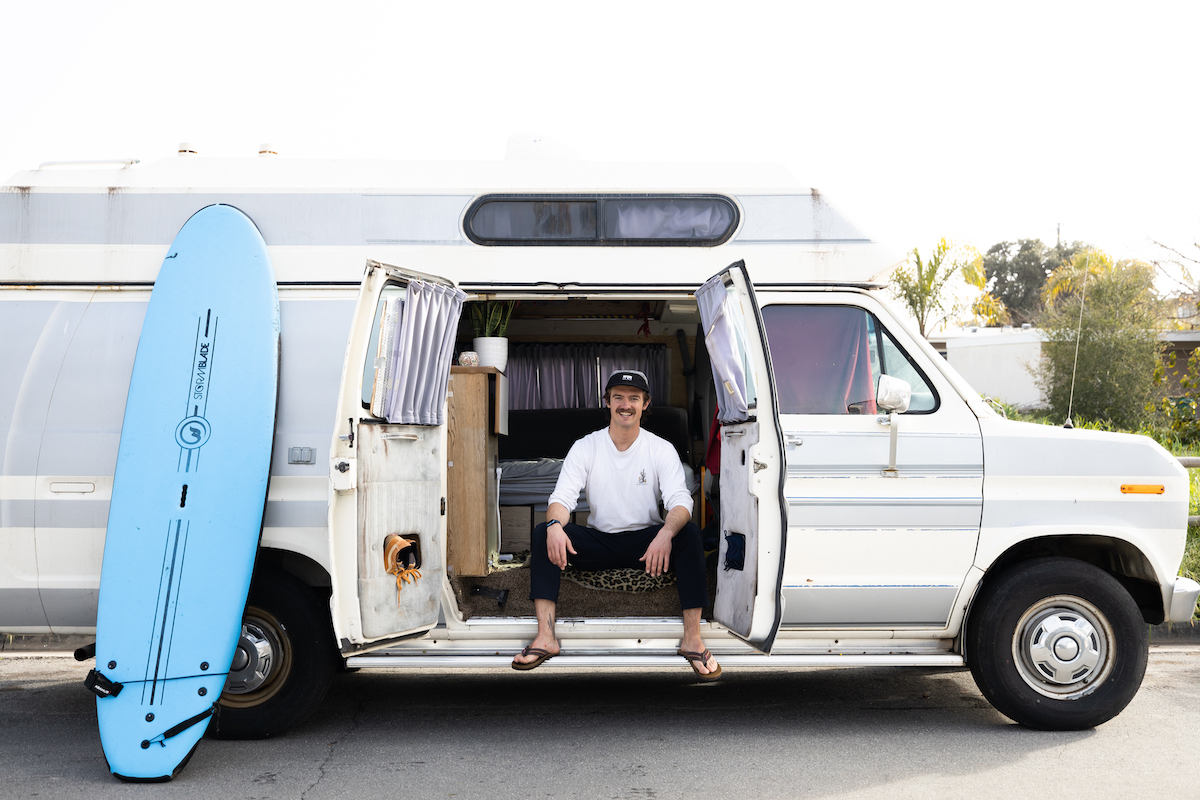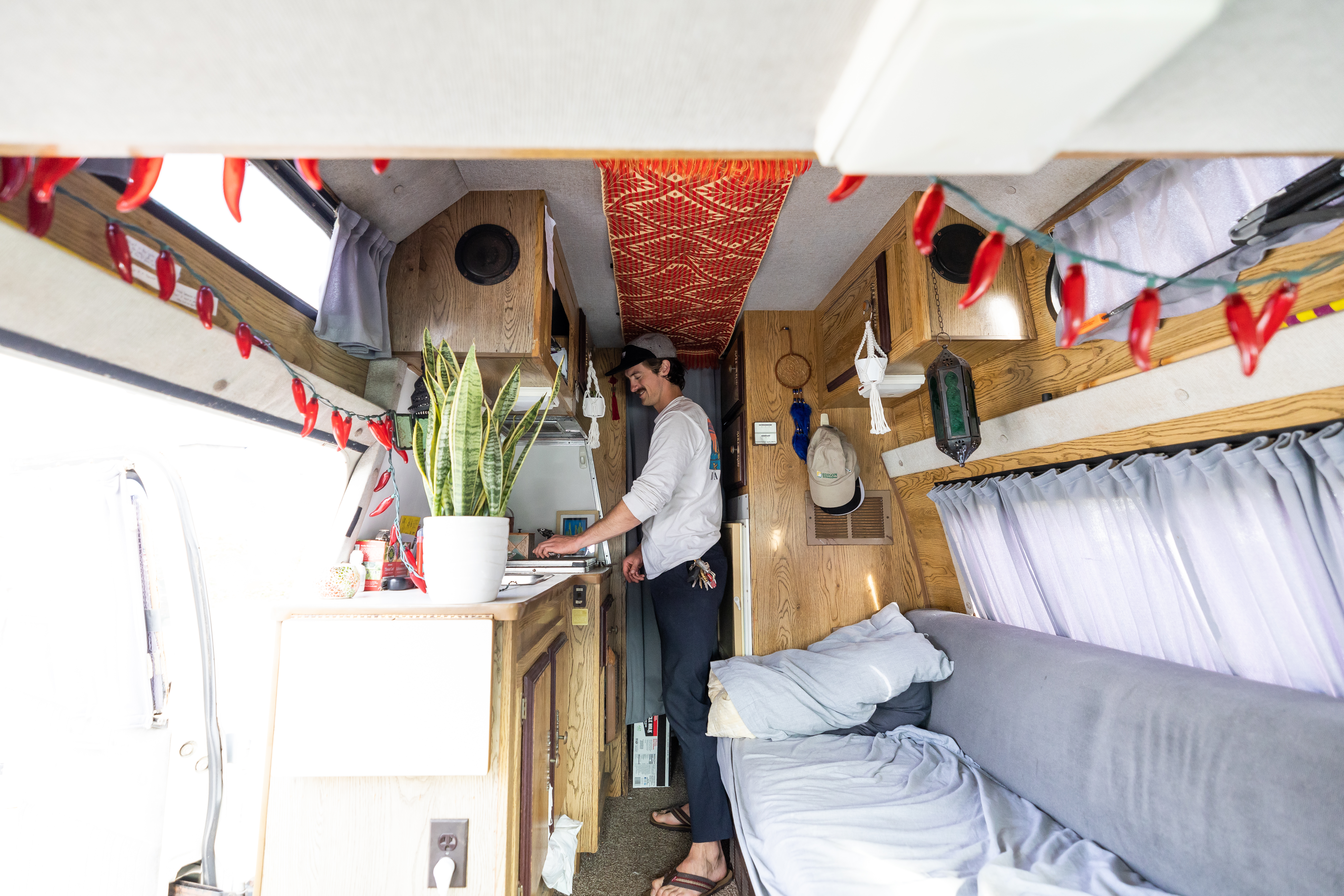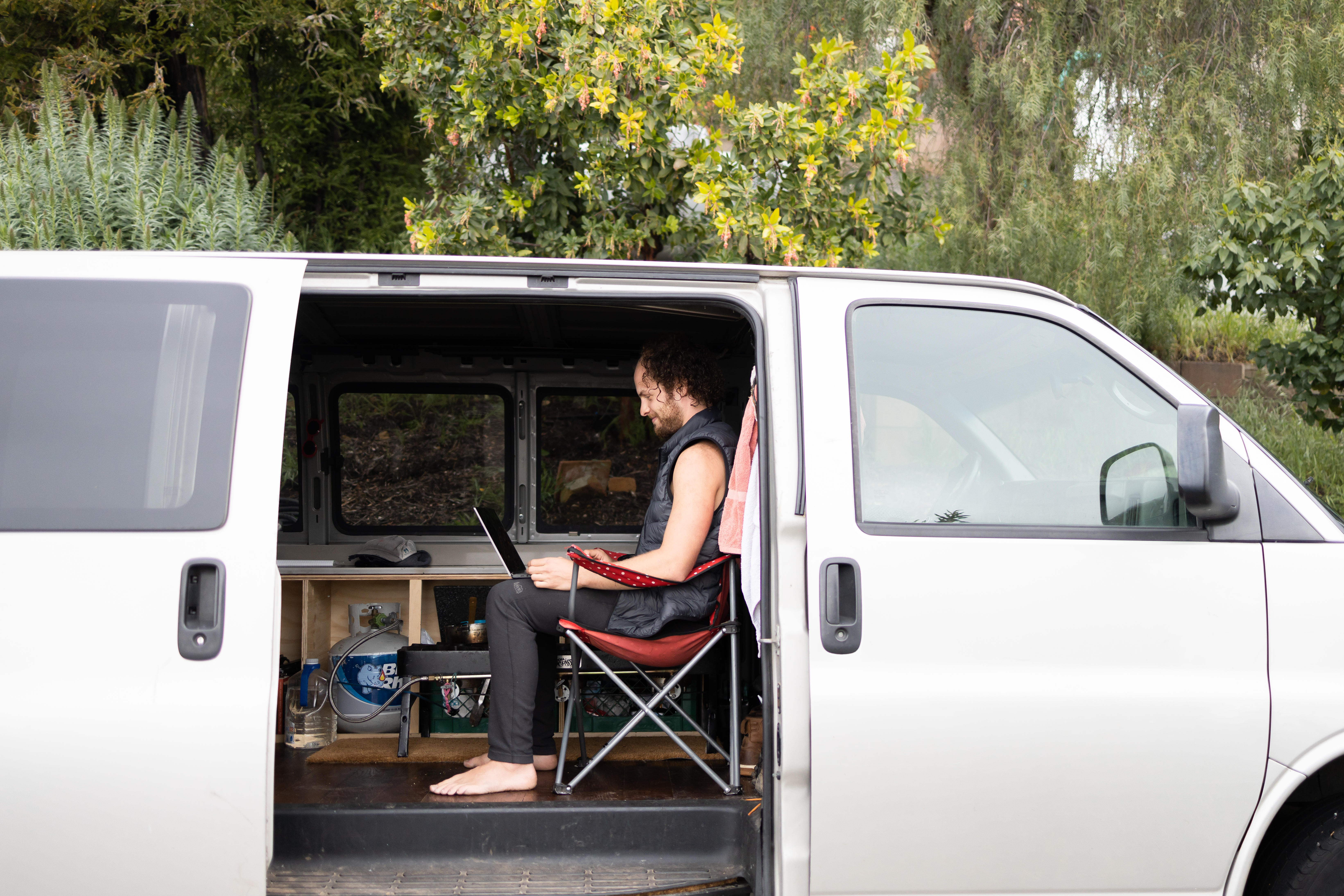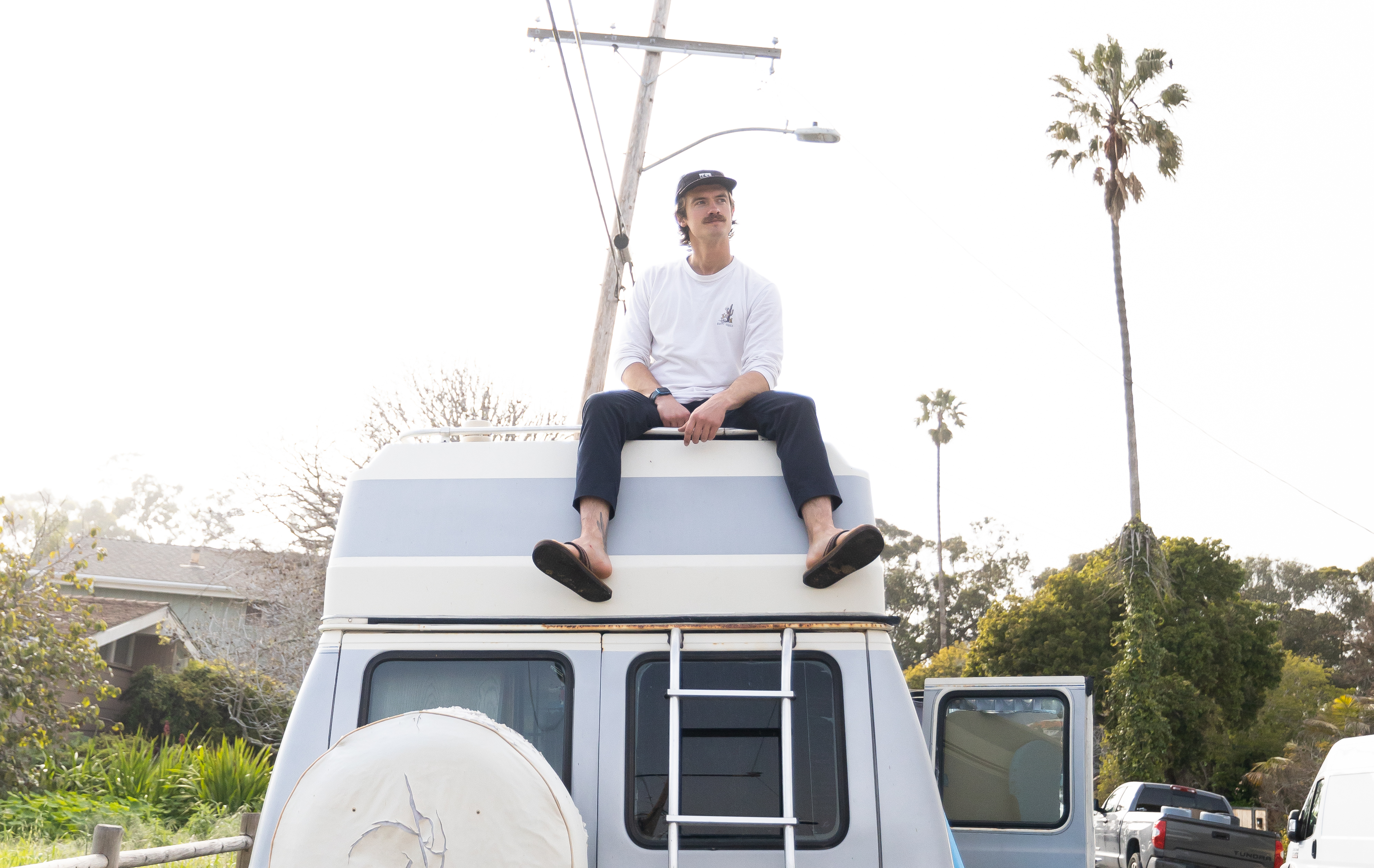#Vanlife Goes to School
in Isla Vista
Three UCSB Students Trade
Four Walls for Four Wheels
By Riley Burke | March 30, 2023

OLDIE BUT GOODIE: UCSB student Christopher LaBorde lived in university-owned housing before moving into his “oldie,” a 1985 Ford Coachman camper van. | Credit: Ingrid Bostrom
In late October, UC Santa Barbara senior Yehudah Rice sits in the warm Isla Vista sun. He wears a stretched-out tank top bearing the image of Johnny Cash in front of a faded American flag. Between careful bites of an apple, he flashes a kind smile. His tattered baseball cap looks as well-traveled as he does.
For the past two years, Rice has been to many places. When he’s not going to college — and even when he is — his home is everywhere and nowhere. He lives wherever he parks his van-turned-living-quarters, a 15-seater Chevy Express, on any given night.
“It has given me more of a sense of being comfortable in all spaces. When you have a home, there’s this sense of coming home, and of being safe in that space. But when you live in a van, everywhere you go kind of becomes that,” he said. “And so I’ve learned how to stretch out and root or ground into wherever I am, which is nice. It’s an expansive feeling.”

Rice is just one of the increasing number of people residing in vehicles in Santa Barbara County, a population that has steadily grown in recent years. Santa Barbara’s annual Point-in-Time Count — the county’s census of those experiencing sheltered and unsheltered homelessness — reported that the number of individuals living in vehicles rose from 398 in 2019 to 611 in 2023. As California’s housing crisis tightens its grip on Isla Vista and soaring inflation continues to push up the already-high cost of living in Santa Barbara, more UCSB students like Rice have begun to think differently about how and where they choose to live.
In fall 2022, I spoke with some of them — three UCSB students who have chosen to join the thousands who partake in what on Instagram is labeled #vanlife, a hashtag with more than 14 million posts. The reasons they gave me for taking to the road vary widely. While financial concerns are a common denominator, these young men occupy a spectrum of personal motivations and existential concerns about not only their own lives but also the state of our community and country. They are responding to a continuing crisis in the UC system defined by a lack of affordable housing and a rising cost of living. They are adapting to a shifting America, defined by hardship but tinged with human resilience. They are the dreamers of a new American dream.
Many do not have a choice when it comes to living in a vehicle — car-bound homelessness is on the rise in Santa Barbara and represents a larger homelessness crisis in California. For others, however, van life is far from a sign of desperation and is rather an expression of choice. Christopher LaBorde, a 28-year-old UCSB student, has lived in a vehicle for 10 months. Previously, LaBorde lived in university-owned housing that, while affordable enough for him, still felt like too much.
“I believe that, especially in California and for our generation, more people are being influenced — not forced, but influenced — to adopt this lifestyle. And I would imagine that’s mostly because of rising living costs and house prices,” said LaBorde, who resides in what he calls “an oldie,” a 1985 Ford Coachman camper van.
“[In the past] there’s been enough wealth that people can afford houses and a place to live. And it seems like that prospect has been slipping for our generation,” LaBorde told me. For him, van life is “revealing itself as a natural lower-cost alternative to buying real estate.”
LaBorde, a transfer student from Altadena, California, with a thick mustache and bright blue eyes, first considered living in a vehicle in 2017 after spending five months hiking 1,800 miles of the Pacific Crest Trail.
“When I was nearing the end, I realized I’m going to go back into normal society, and I’m the happiest I’ve ever been, and I have close to nothing — I have 20 things,” LaBorde said. “So I thought, ‘How can I bring this kind of ethic back when I’m in society?’ And I was like, ‘Well, I could just get a van.’”

VAN-BOARDING: While LaBorde has much of what he needs inside his van, he unofficially subleases the kitchen, shower, and other amenities of a nearby Isla Vista home, a practice known as “van-boarding.” | Credit: Ingrid Bostrom
Another vehicle-dweller I spoke with also cited “living with little” as both a philosophy and a necessity. Brett Aho, a PhD candidate studying comparative political economy at UCSB, sees van life as a way of rejecting excess consumption.
“Anti-consumerism, I think, plays a role in sort of a trend where, if you live in a van, the amount of stuff you have is limited to what’s around you. It’s a rejection of hyper-consumerism and this idea that you need to own a bunch of shit. You don’t,” said Aho.
This 34-year-old from Seattle wears a baseball cap that says “Eat the Rich” in bold letters. He has lived in a 1999 GMC Savana van for the better part of six months. After returning from a master’s program in Germany last year, Aho began looking for housing in Santa Barbara and found it firmly incompatible with his PhD student salary of $2,500 a month — roughly equivalent to the average cost of one month’s rent for a one-bedroom apartment in Goleta. As a result, Aho bought a van.
Aho and LaBorde do not travel with their vans during the school year. LaBorde only takes his “oldie” around the block occasionally so the police don’t mistake it for an abandoned vehicle. Mostly, he stays in Isla Vista as a “van-boarder,” a common practice in the area. He pays a small amount — $200 a month — to unofficially sublease the amenities of a home he parks near. There, he can shower, cook, and maintain all of the conveniences of a traditional home while he continues to live in a space that’s not only more affordable but preferable.
“I could understand how a bad situation could force somebody into [van life]. And thankfully, that’s not how it was with me. I had a choice and did it willingly,” LaBorde said. “I mean, I love it. I want to continue doing it. It’s even enjoyable and comfortable.”
During the summer, though, this statistics and data science student takes to the road. Last year, he traveled between South Carolina and California using the money he had saved doing part-time work during the school year.
“You can go anywhere, park anywhere. You have life support; you have the things you need,” he said. “That’s part of why it’s so romantic. It’s the freedom. You’re not tied down. You’re transient.”
Transience has become, to some, an alternative to the staid American notions of idyllic, capitalistic-minded hard work. Rice, the Johnny Cash–clad 25-year-old, finds that living in a more-affordable vehicle allows him the freedom of working less.
“If I’m spending a lot of money, then I have to spend a lot of time working to make money and pay for those things. And so if I don’t want to work as much, I need to spend less money, and the van enables that,” he said.

STAYING CONNECTED: Vehicle-dwellers like UCSB senior Yehuda Rice — who lived for six months in a Toyota Corolla before buying his 15-seater Chevy Express — use mobile hotspots to access the internet on their laptops. | Credit: Ingrid Bostrom
The philosophy and education student currently volunteers at a local high school and prefers to take on odd jobs here and there so that his transience does not limit the work he is able to do. He works at times as a freelance web designer and has worked in charter schools and even as a tour guide in downtown Santa Barbara.
Saving cash remains a top priority for the vehicle-dwellers I spoke to. Before Rice bought his van, he lived for six months in a Toyota Corolla because he did not want to pay the sky-high rents in Santa Barbara. All three reported that they save significantly because of their living situations. Even as some, like LaBorde, live willingly in their vehicles, the reality of their living conditions and the nuances of inequity present in America are not lost on these vehicle-dwellers.
“It is a reflection of the massive wealth disparities that we have in this country,” said Aho. “Especially in Santa Barbara, where the insanely rich live in their giant mansions in Montecito and the hills. [Then,] so many people live in their cars.”
Rice thinks that vehicle-dwelling has arisen in response to the decaying of our notions of the American dream, while also reflecting perhaps a new version of the dream. “I feel like it’s not attainable anymore. The American dream shows problems with our system and how we’ve mapped that out,” he said. “On the positive side,” he added “we’ve found a way to sort of maybe subvert that American dream and achieve our own dream by having the van and learning that it can be a beautiful, enjoyable lifestyle.”
Similarly, LaBorde thinks our idea of the American dream is shifting. “It’s less a white-picket fence and a dog, which is, like, the image of stability — right? Maybe van-dwelling is, like, the evolution of the American dream. It still has that spirit of owning something while also having … freedom.”
This freedom, like all freedoms, does not come without a price. Engine replacements, broken fuel pumps, and other vehicular troubles are common occurrences, say those in the vehicle-dwelling community. LaBorde once drove down a highway with his head stuck out of his van’s driver’s-side window as the cabin filled with smoke after his heater core blew.
There is also the problem of parking. While LaBorde van-boards and can park consistently on a residential street, Rice and Aho do not and must move around more often. They carry out the act of “stealth camping,” a common practice among vehicle-dwellers. Rice says he moves every one or two days, splitting time between Isla Vista and Santa Barbara, while Aho utilizes parking garages that he has permitted access to.
“The whole idea of stealth camping in the van is that you don’t want people to notice that you’re living in your van, because you don’t want to get hassled or worse,” said Aho.
Despite these challenges, these travelers persist. With the gift of modern technology and a resilient spirit, van-lifers can make do with what they have. LaBorde charges his electronics when he’s in class. Rice showers at the local gym. Aho uses his phone’s mobile hotspot to connect his computer to the internet in his van. Both Aho and Rice have makeshift kitchens in their vans and make use of both public and on-campus bathrooms.
As the three vehicle-dwellers look toward the future, they envision lives of varying outcomes — lives inside and outside of vehicles. Some, such as Aho, will not continue their van-life journey post-graduation. Others, such as Rice, will until the responsibilities of adulthood, of raising children and planting roots, take precedence. LaBorde, though, hopes to continue this way of life indefinitely.
“When you’re on the road, the world comes at you fast. It’s not this structured, stable environment like school. It’s dynamic, and it’s changing,” LaBorde said. “You have to be adaptable and flexible, and it can be stressful and scary. But it can also be super fun and fulfilling. And I don’t think it’s fulfilling, like, just by virtue of me living in a van. I think it’s fulfilling because of the way that I live my life, and I happen to be living in a van.”





You must be logged in to post a comment.